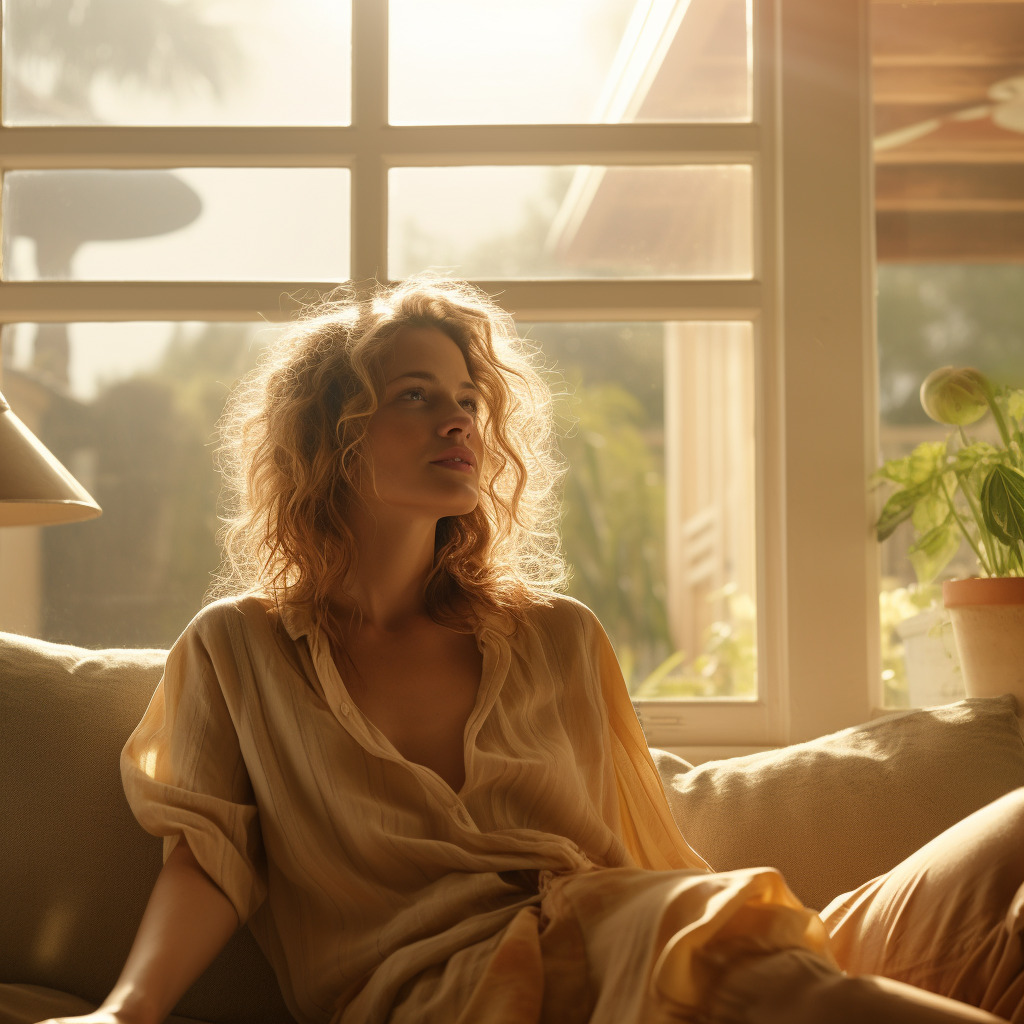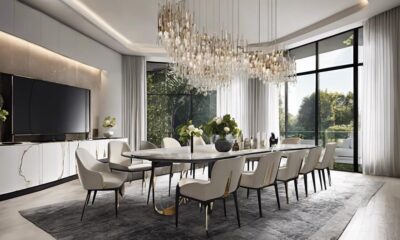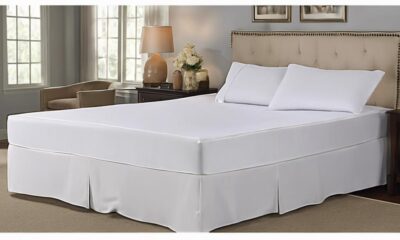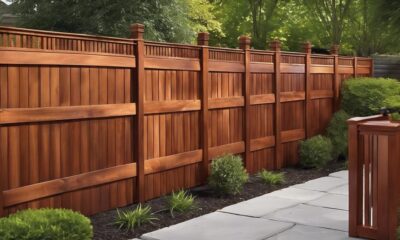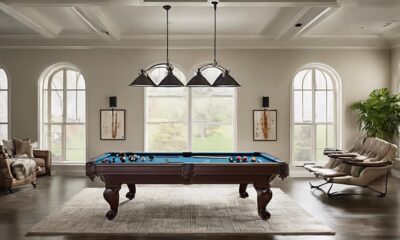Decor
What Decorations Are Used in the Cherry Blossom Festival?
2025
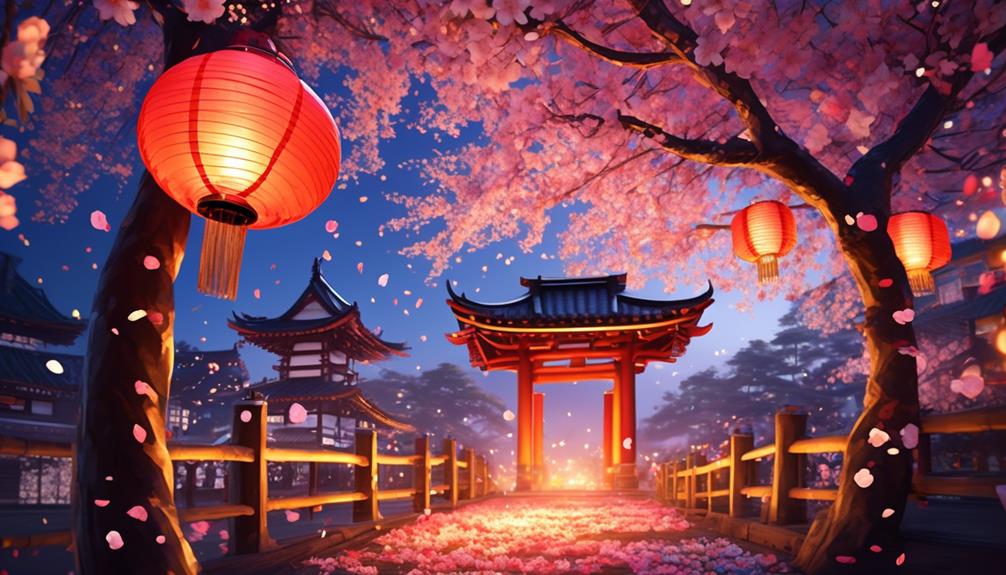
Ah, the Cherry Blossom Festival, a period of tranquil elegance and fine embellishments. We, as modest spectators, are frequently captivated by the variety of decorations that enhance this esteemed occasion.
Lanterns softly illuminate the surroundings, casting a warm glow upon the festivities. Paper fans flutter in the gentle breeze, their intricate designs adding elegance to the scene. Floral arrangements, meticulously crafted, bring bursts of color and fragrance to the atmosphere. Symbolic ornaments, rich in tradition, tell stories of hope and renewal.
And of course, the iconic cherry blossom trees themselves, their delicate petals creating a breathtaking canopy. Silk fabric decorations, hand-painted parasols, and even wishing trees and ceramic pottery all contribute to the visual tapestry of this enchanting festival.
Join us as we delve into the world of Cherry Blossom Festival decorations.
Key Takeaways
- Lanterns and paper fans are meticulously crafted by skilled artisans and add beauty to the festival.
- Symbolic flower arrangements, including cherry blossoms, peonies, and plum blossoms, deepen the cultural significance of the festival and enhance its visual appeal.
- Cherry blossom trees transform the landscape and hold great significance in Japanese culture, symbolizing the beauty and fragility of life.
- Calligraphy artwork, origami decorations, bamboo structures, and other traditional Japanese decorations add cultural richness and diversity to the festival atmosphere.
Lanterns
When it comes to the Cherry Blossom Festival decorations, the lanterns are an essential element that adds a touch of enchantment and radiance to the entire event. Lantern making is an ancient tradition in Japan, and it holds great cultural significance. These lanterns are meticulously crafted by skilled artisans who take pride in their work. Using delicate materials such as washi paper and bamboo frames, the lanterns are carefully constructed to create stunning visual displays.
During the festival, there's a grand lantern procession where these beautiful creations are showcased. The procession is a mesmerizing sight, as hundreds of lanterns illuminate the night sky, creating a magical atmosphere. It's a true testament to the craftsmanship and artistry that goes into making these lanterns.
Each lantern tells a story, with intricate designs and vibrant colors. From traditional Japanese motifs to modern interpretations, the lanterns captivate the audience with their beauty and symbolism. They symbolize the transient nature of life and the ephemeral beauty of the cherry blossoms.
The lanterns not only enhance the visual appeal of the festival but also deepen the cultural experience for attendees. They serve as a reminder of the rich history and traditions that are celebrated during this time. So, when you visit the Cherry Blossom Festival, be sure to take a moment to admire the lanterns, for they're a true representation of the enchantment and radiance that this festival brings.
Paper Fans
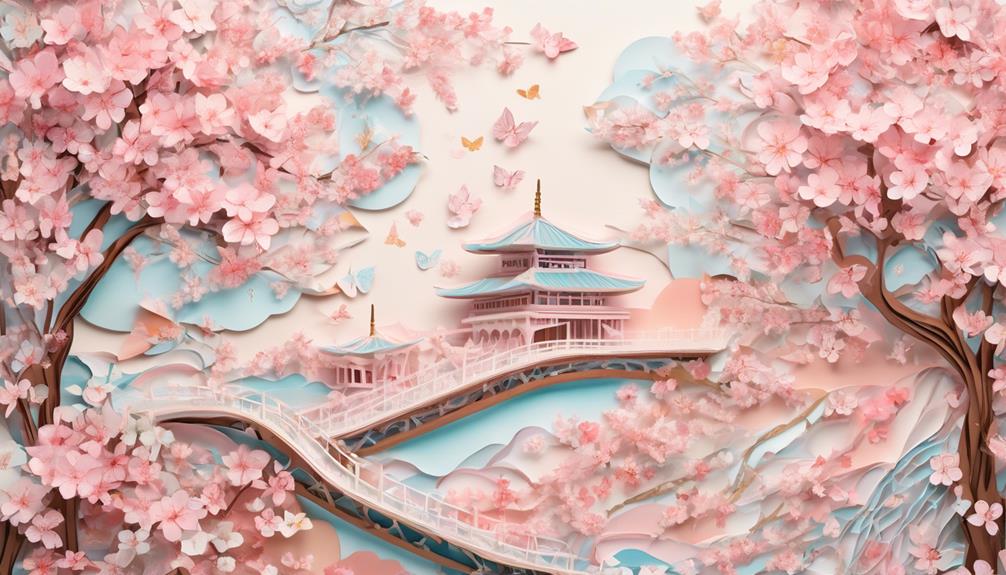
The delicate folds and vibrant designs of paper fans add a touch of elegance and grace to the Cherry Blossom Festival. These traditional Japanese accessories aren't only functional but also serve as beautiful decorations during the festival. Here are some interesting facts about paper fans:
- Paper fans have been used in Japan for centuries and are an integral part of Japanese culture. They were originally made by folding bamboo strips and attaching delicate paper to create a lightweight and portable accessory. The art of folding paper, known as origami, is often used to create intricate designs on the fans.
- Traditional origami designs are commonly found on paper fans. Cherry blossoms, with their delicate petals and vibrant colors, are a popular motif on these fans, symbolizing beauty and the transient nature of life. Other common designs include traditional patterns, landscapes, and even images of famous Japanese landmarks.
Paper fans not only provide relief from the heat during the festival but also serve as a visual representation of the beauty and artistry of Japanese culture. Their intricate folds and vibrant designs make them a captivating addition to the Cherry Blossom Festival, adding an extra layer of sophistication and charm to the celebration.
Floral Arrangements
When it comes to cherry blossom festivals, floral arrangements play a significant role in setting the atmosphere and capturing the essence of the event. Symbolic flower arrangements are meticulously crafted to convey meaning and evoke emotions.
From traditional displays in the form of ikebana to elaborate centerpieces adorned with cherry blossoms, these arrangements add a touch of elegance and beauty to the festival decorations.
Symbolic Flower Arrangements
Floral arrangements play a significant role in the Cherry Blossom Festival, symbolizing the beauty and ephemeral nature of the cherry blossoms. These arrangements are carefully crafted to convey symbolic flower meanings and reflect the cultural significance of cherry blossoms.
Here are two sub-lists to engage you further:
- Flower Selection: The floral arrangements typically feature cherry blossoms as the main flowers, representing the transient nature of life and the beauty of the present moment. Other flowers that may be included are peonies, symbolizing prosperity and good fortune, and plum blossoms, signifying resilience and perseverance.
- Arrangement Styles: There are various traditional Japanese flower arrangement styles used in the Cherry Blossom Festival. One popular style is ikebana, which emphasizes simplicity and asymmetry. Another style is hanamai, where flowers are arranged to create a harmonious and balanced composition. These different styles enhance the visual appeal of the festival and showcase the artistry behind the flower arrangements.
These symbolic flower arrangements not only add aesthetic beauty to the festival, but also deepen the cultural significance of the cherry blossoms, making the Cherry Blossom Festival a truly captivating experience.
Traditional Floral Displays
As we explore the world of traditional floral displays at the Cherry Blossom Festival, we're transported into a realm of enchanting beauty and cultural significance.
Traditional flower arrangements play a vital role in the festival, showcasing the delicate artistry of Japanese culture. These arrangements, known as Ikebana, are carefully composed to emphasize balance, harmony, and simplicity. Ikebana isn't just about arranging flowers; it's a form of artistic expression that embodies the principles of Zen philosophy.
Each element in the arrangement holds deep cultural symbolism, representing various aspects of nature and human existence. The choice of flowers, their colors, and the placement of each stem all contribute to the overall aesthetic and meaning of the arrangement.
These traditional floral displays not only enhance the visual appeal of the Cherry Blossom Festival but also serve as a reminder of the profound connection between nature and human life.
Symbolic Ornaments
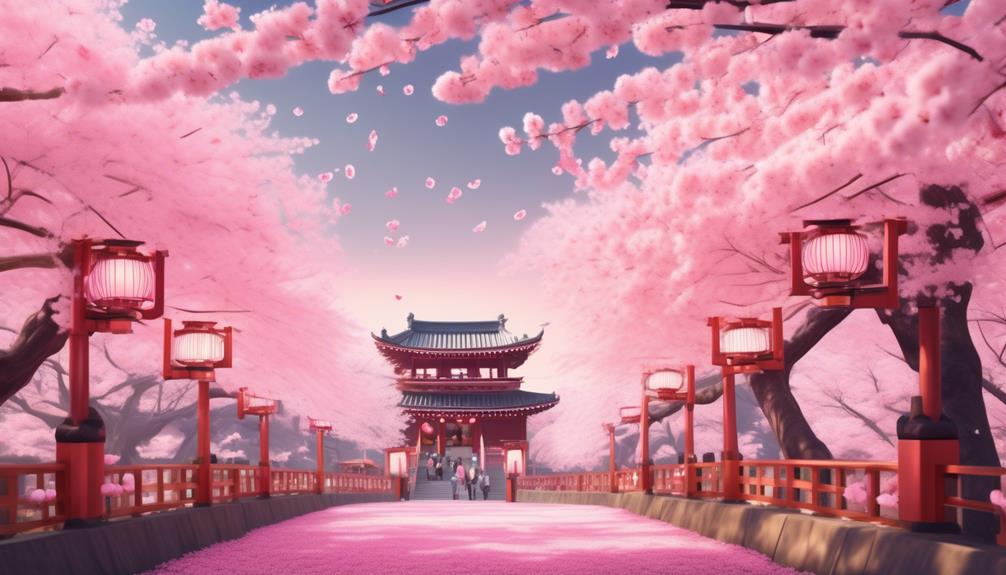
What are some of the meaningful ornaments that can be found at the Cherry Blossom Festival? The festival isn't just about beautiful flowers but also incorporates symbolic ornaments that add depth and significance to the event. These ornaments reflect the rich cultural heritage of Japan and create a captivating atmosphere for festival-goers.
At the Cherry Blossom Festival, you'll come across a variety of symbolic ornaments. Here are two sub-lists that highlight some of the most prominent ones:
1. Traditional Music Instruments:
- Koto: This stringed musical instrument, often played with a pick called a bachi, produces enchanting melodies that resonate through the festival grounds. Its elegant design and soothing sounds evoke a sense of tranquility and harmony.
- Taiko Drums: These large drums, made of wood and animal skin, are a staple in Japanese festivals. The rhythmic beats of the taiko drums reverberate through the air, energizing the crowd and creating a lively atmosphere.
2. Decorative Lanterns:
- Paper Lanterns: Beautifully crafted paper lanterns are hung throughout the festival venue, illuminating the surroundings with their soft, warm glow. These lanterns symbolize the transience of life and the fleeting beauty of the cherry blossoms.
- Stone Lanterns: These traditional stone lanterns, known as tōrō, serve as both decorative elements and symbolic markers. They represent the guiding light that leads visitors through the festival, enhancing the mystical ambiance.
These symbolic ornaments not only add visual appeal but also contribute to the overall cultural experience of the Cherry Blossom Festival. They bring together music, art, and tradition, creating an immersive and memorable celebration of Japan's cherished cherry blossoms.
Cherry Blossom Trees
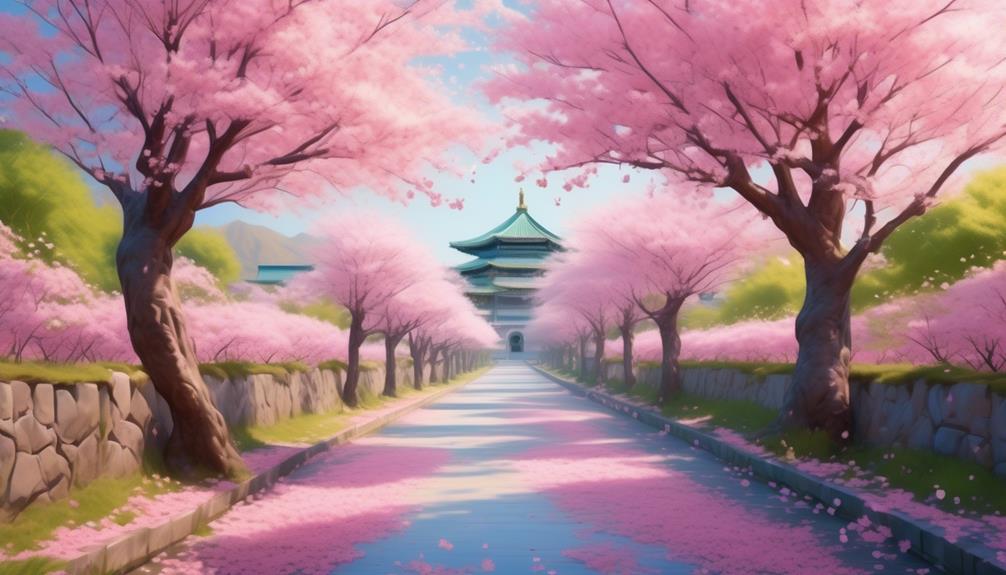
Cherry Blossom trees transform the landscape into a breathtaking sea of delicate pink petals, captivating all who behold their ephemeral beauty. These iconic trees hold great significance in Japanese culture and are deeply rooted in cherry blossom symbolism. The blossoms represent the beauty and fragility of life, reminding us of its fleeting nature. They're a symbol of renewal, hope, and the arrival of spring.
During the Cherry Blossom Festival, these trees take center stage, drawing crowds from all over the world. Cherry blossom viewing parties, known as hanami, are a popular tradition in Japan. Friends, families, and colleagues gather under the blooming trees, spreading blankets and enjoying food and drinks together. It's a time of celebration and appreciation for the beauty of nature.
The Cherry Blossom Festival isn't limited to Japan alone; it has spread to other countries as well. Many cities around the world have planted cherry blossom trees to create their own version of the festival. These trees serve as a reminder of the enduring cultural significance of the cherry blossom and provide a sense of connection to Japanese traditions.
Kimono Displays
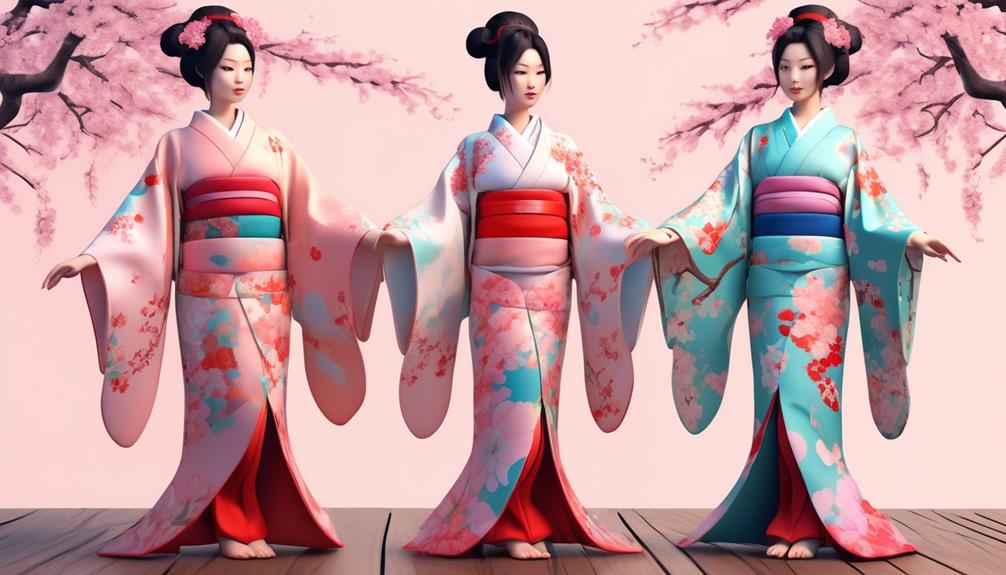
Under the blooming cherry blossom trees, another captivating sight awaits festival-goers: the vibrant displays of traditional kimonos. Kimonos, the epitome of Japanese fashion, showcase the rich cultural heritage of Japan. Festival attendees are treated to a visual feast of colors, patterns, and intricate designs as they admire these stunning garments.
Here are two fascinating aspects of the kimono displays:
- Kimono Fashion: The kimono, a traditional Japanese garment, is known for its simple T-shape and straight-line cut. Festival-goers can marvel at the wide variety of kimono styles on display, ranging from the elegant furisode worn by unmarried women to the more subdued homongi worn by married women. Each kimono tells a story through its choice of fabric, colors, and patterns, reflecting the wearer's status, occasion, and personal taste.
- Cultural Heritage: The kimono represents more than just a fashion statement; it embodies Japan's cultural heritage. Passed down through generations, the art of kimono-making is a meticulous process that requires skill and patience. The intricate patterns, often inspired by nature, are meticulously hand-painted or woven into the fabric. By showcasing these traditional garments, the cherry blossom festival not only celebrates the beauty of the cherry blossoms but also pays homage to Japan's rich cultural heritage.
As festival-goers stroll beneath the cherry blossom trees, they're transported to a world where tradition meets beauty, where the elegance of the kimono captures the essence of Japanese culture.
Calligraphy Artwork
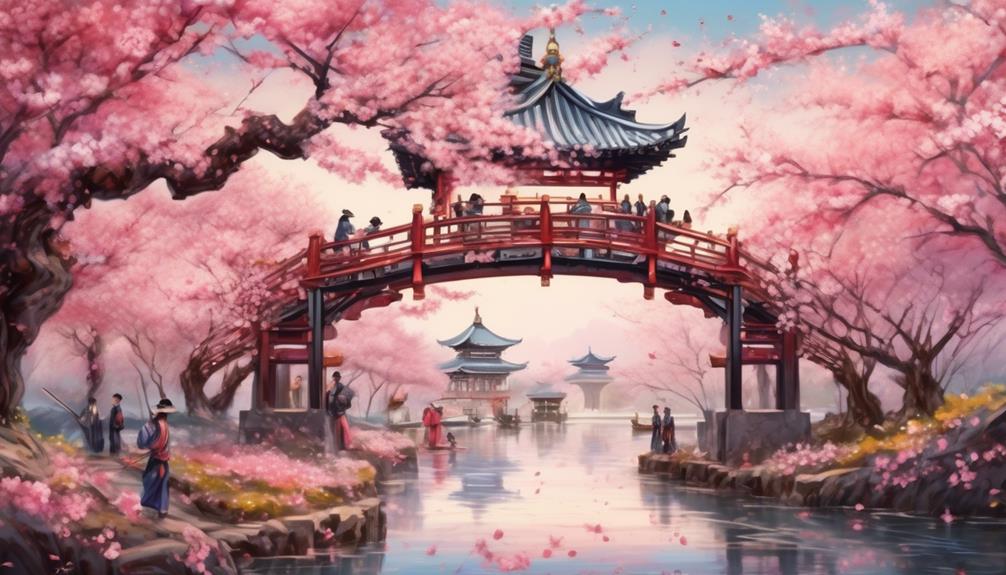
Amidst the enchanting ambiance of the Cherry Blossom Festival, the intricate strokes of calligraphy artwork grace the festival grounds, captivating visitors with their beauty and meaning. Calligraphy, the art of beautiful writing, has a rich history and is deeply rooted in Japanese culture. Its origins can be traced back to ancient China, where it was initially used for religious texts and government documents. Over time, calligraphy techniques were introduced to Japan and integrated into various aspects of Japanese society, including festivals like the Cherry Blossom Festival.
To truly appreciate the artistry of calligraphy, one must understand the skill and precision required to create each stroke. Calligraphers use a brush, ink, and paper to create their masterpieces, carefully controlling the pressure and angle of the brush to achieve the desired effect. Each stroke is deliberate and intentional, conveying both aesthetic appeal and deep meaning.
To delve deeper into the world of calligraphy, let's explore a table that showcases three common calligraphy techniques and their significance:
| Calligraphy Technique | Description | Significance |
|---|---|---|
| Gyosho | Semi-cursive script, a balance between Kaisho and Sosho styles | Represents elegance and fluidity |
| Kaisho | Block script, characterized by straight, rigid strokes | Symbolizes stability and strength |
| Sosho | Cursive script, known for its flowing and dynamic strokes | Conveys energy and spontaneity |
As visitors wander through the Cherry Blossom Festival, they can admire the calligraphy artwork and gain a deeper understanding of the rich history and meaning behind each stroke. It is a testament to the enduring beauty and cultural significance of this ancient art form.
Origami Decorations
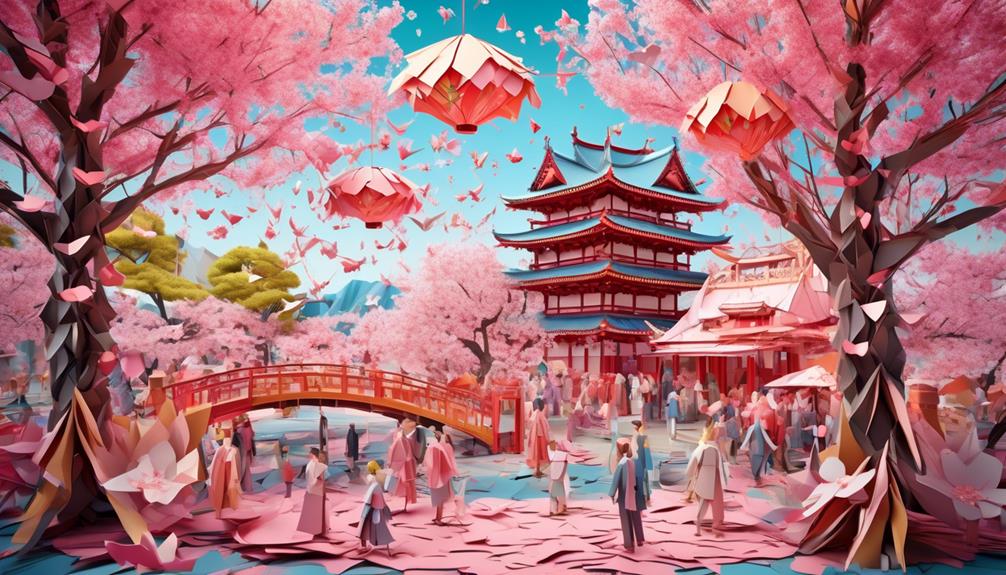
When it comes to Cherry Blossom Festival decorations, one can't overlook the beauty and significance of origami.
Origami, the art of folding paper into intricate shapes and designs, holds a special place in Japanese culture. These symbolic paper crafts are often made using traditional origami techniques and showcase the creativity and skill of the artisans.
From delicate cherry blossom flowers to graceful cranes, origami decorations add an elegant touch to the festival ambiance.
Symbolic Paper Crafts
Symbolic Paper Crafts, such as origami decorations, add a touch of elegance and cultural significance to the Cherry Blossom Festival. These delicate paper crafts showcase the mastery of traditional origami designs, which are folded with precision and care.
Here are two sub-lists highlighting the importance and beauty of these symbolic paper crafts:
- Cultural Significance:
- Origami represents a connection to nature and the changing seasons, mirroring the fleeting beauty of cherry blossoms.
- The act of folding paper is considered a meditative practice, promoting mindfulness and concentration.
- Decorative Elements:
- Origami cherry blossoms are intricately folded and often displayed as garlands or hanging ornaments.
- Cranes, a symbol of luck and longevity, are popular origami designs that are used to decorate the festival venues.
These symbolic paper crafts not only enhance the visual appeal of the Cherry Blossom Festival but also serve as a reminder of the rich cultural heritage and artistic traditions associated with this annual celebration.
Traditional Origami Designs
As we continue exploring the enchanting world of Cherry Blossom Festival decorations, let us now immerse ourselves in the artistry of traditional origami designs, which grace the festival venues with their intricate beauty. Origami, the ancient Japanese art of paper folding, has a rich history and cultural symbolism that adds depth to the festival atmosphere.
Origami decorations are meticulously crafted using traditional paper folding techniques passed down through generations. These delicate creations range from simple flowers and animals to complex geometric shapes and intricate designs. The use of vibrant colors and patterns enhances the visual appeal and captures the essence of the Cherry Blossom Festival.
To give you a glimpse of the mesmerizing origami designs, here is a table showcasing some popular examples:
| Origami Design | Symbolism |
|---|---|
| Sakura Flower | Beauty and Transience |
| Tsuru Crane | Longevity and Good Luck |
| Koi Fish | Prosperity and Success |
| Maneki-neko | Fortune and Protection |
| Samurai Helmet | Bravery and Honor |
Each origami design carries its own cultural significance, adding depth and meaning to the Cherry Blossom Festival. These traditional paper creations truly embody the spirit of Japanese craftsmanship and serve as beautiful decorations during this joyous celebration.
Bamboo Structures
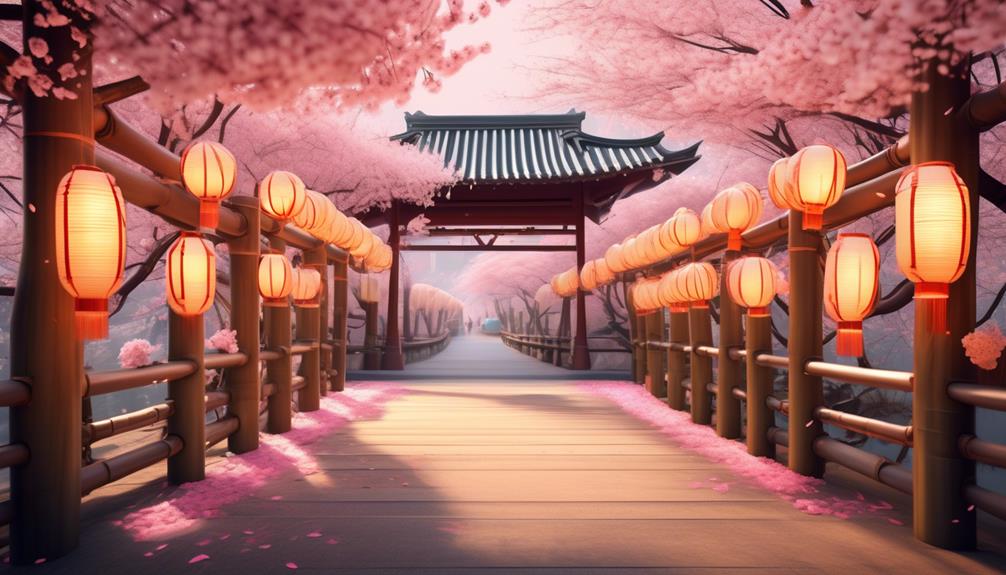
Bamboo structures stand tall and graceful, adding an elegant touch to the vibrant atmosphere of the Cherry Blossom Festival. These structures, deeply rooted in Japanese architecture and craftsmanship, play an essential role in creating a captivating ambiance for festival-goers.
Here are two key aspects of bamboo structures that make them an integral part of the festival:
- Bamboo Crafts: Skilled artisans meticulously fashion bamboo into a variety of decorative pieces that enhance the festival's aesthetic appeal. From delicate lanterns that illuminate the pathways to intricate bamboo fences that define the festival grounds, these crafts showcase the versatility of bamboo as a material. The meticulous craftsmanship of these bamboo structures exemplifies the Japanese dedication to precision and attention to detail.
- Japanese Architecture: Bamboo structures also reflect the influence of traditional Japanese architecture in the festival's design. The use of bamboo in structures such as torii gates, archways, and pavilions adds an authentic touch that transports visitors to the serene landscapes of Japan. These structures not only serve as stunning visual focal points but also symbolize the harmonious integration of nature and human-made elements.
The combination of bamboo crafts and Japanese architectural elements creates a truly immersive experience at the Cherry Blossom Festival. As festival-goers stroll through the enchanting displays of bamboo structures, they're enveloped in an atmosphere that celebrates the beauty of nature and the rich cultural heritage of Japan.
Traditional Music Instruments
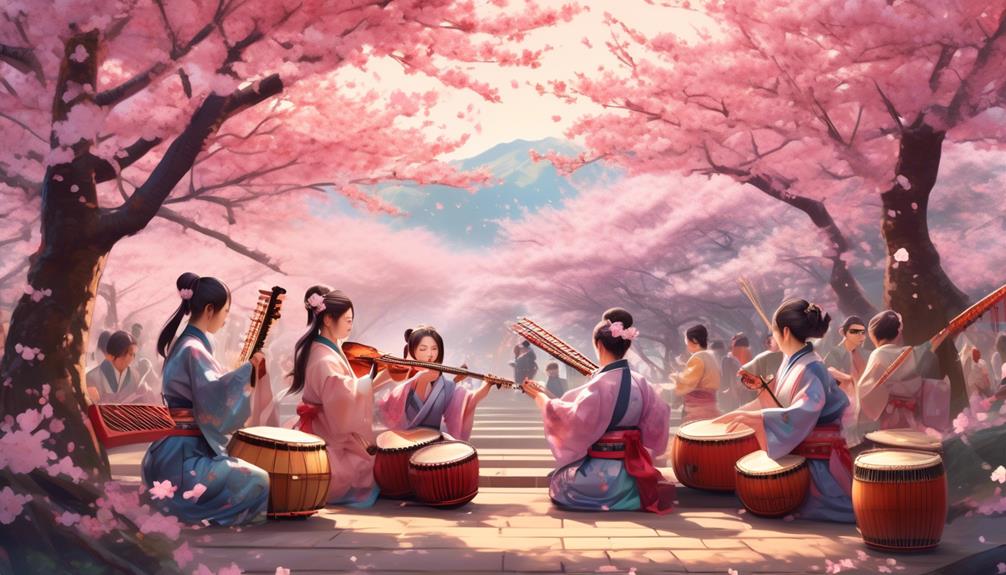
As we continue our exploration of the Cherry Blossom Festival decorations, let's now turn our attention to the traditional music instruments that play a vital role in this vibrant celebration.
These instruments hold a deep cultural significance, reflecting the rich history and traditions of Japan. From the elegant melodies of the koto to the rhythmic beats of the taiko drums, the variety of instrument types adds an enchanting musical element to the festival.
Cultural Significance
Traditional music instruments hold a significant place in the cultural celebration of the Cherry Blossom Festival. These instruments are deeply rooted in the cultural traditions of Japan and have a rich historical significance.
Here are two sub-lists that highlight the importance of traditional music instruments in the festival:
- Cultural Traditions:
- Traditional music instruments, such as the shamisen and taiko drums, are an integral part of Japanese culture.
- They've been played for centuries, passing down the cultural heritage from one generation to another.
- Historical Significance:
- The use of traditional music instruments in the Cherry Blossom Festival reflects the historical connection between music and nature in Japanese culture.
- These instruments evoke a sense of harmony and tranquility, enhancing the overall experience of the festival.
Instrument Types
The cultural celebration of the Cherry Blossom Festival continues to captivate attendees with its vibrant atmosphere, and at the heart of this enchanting event are the various types of traditional music instruments that add an immersive and melodious touch to the festivities. These traditional instruments hold a deep cultural significance and are an integral part of Japanese music and culture.
Here is a table showcasing some of the traditional instruments commonly used during the Cherry Blossom Festival:
| Instrument | Description |
|---|---|
| Koto | A thirteen-stringed zither-like instrument, known for its delicate and soothing sound. |
| Shakuhachi | A bamboo flute that produces a hauntingly beautiful tone and is often used in traditional Zen Buddhist music. |
| Taiko drums | Large drums played with sticks, producing powerful and rhythmic sounds that resonate throughout the festival. |
| Shamisen | A three-stringed instrument with a distinct twang, used to accompany traditional Japanese folk songs and dances. |
These traditional instruments not only entertain festival-goers but also serve as a way to honor and preserve Japanese cultural heritage. Their unique sounds create an atmosphere of harmony and tranquility, enhancing the overall experience of the Cherry Blossom Festival.
Tea Ceremony Utensils
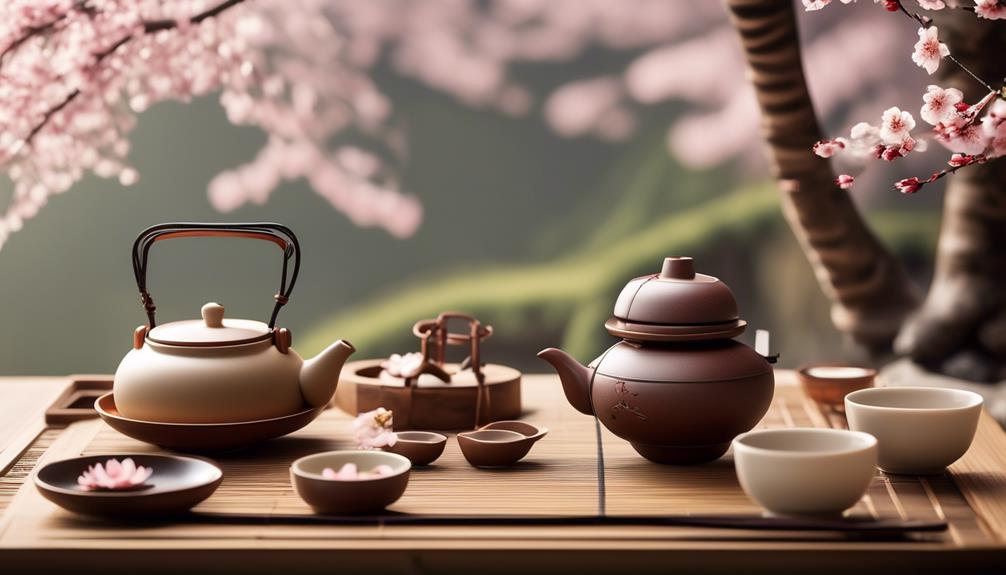
We are now going to explore the various utensils used in the captivating tea ceremony. The tea ceremony is a cherished tradition in Japanese culture, encompassing not only the act of preparing and serving tea but also the rituals and etiquette that surround it. To fully appreciate the beauty and significance of this ceremony, it's essential to understand the utensils that are used.
Here are the key utensils you can find in a traditional tea ceremony:
- Chawan: The chawan, or tea bowl, is an integral part of the tea ceremony. It's a wide, shallow bowl that's used to serve matcha, the powdered green tea used in the ceremony. The chawan is often handcrafted and its unique design adds to the aesthetic appeal of the ceremony.
- Chasen: The chasen is a bamboo whisk used to mix the matcha powder with hot water. It's an essential tool in the tea ceremony, as it creates a frothy and smooth consistency to enhance the flavor of the tea.
- Chashaku: The chashaku is a bamboo scoop used to measure the right amount of matcha powder. It's carefully crafted and its shape allows for precise measuring, ensuring that the right balance of tea is used in each serving.
These utensils, steeped in tea ceremony rituals and tradition, play a crucial role in creating an authentic and immersive experience for tea ceremony enthusiasts. Mastering the use of these utensils is an art form in itself, requiring precision, grace, and a deep respect for the tea ceremony tradition.
Silk Fabric Decorations
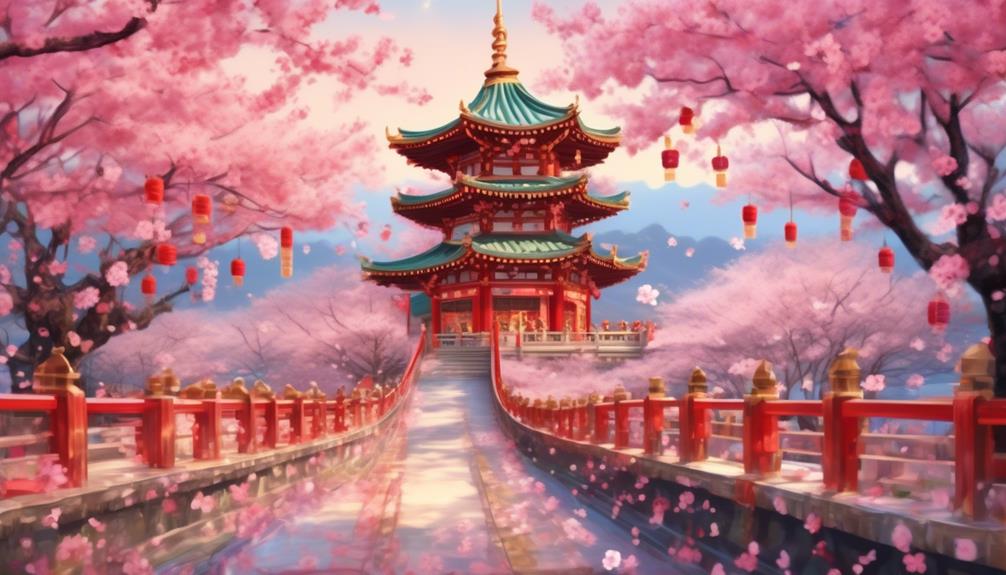
When it comes to the Cherry Blossom Festival, silk fabric decorations play a crucial role in creating a vibrant and elegant atmosphere.
Traditional silk lanterns, with their intricate designs and soft glow, add a touch of enchantment to the festival grounds.
Additionally, silk flower arrangements bring bursts of color and beauty, mimicking the delicate cherry blossoms themselves.
These silk fabric decorations truly enhance the overall aesthetic of the festival, making it a visually stunning experience for all who attend.
Traditional Silk Lanterns
Adorned with intricate patterns and vibrant colors, traditional silk lanterns illuminate the Cherry Blossom Festival, casting a magical glow over the festivities. These exquisite lanterns are the result of centuries-old traditional lantern making techniques, passed down through generations.
The craftsmanship involved in creating these silk lanterns is truly remarkable. Here are some fascinating aspects of traditional silk lanterns:
- Materials: Silk fabric is carefully chosen for its luxurious texture and ability to transmit light, adding to the lantern's ethereal charm.
- Design: Traditional silk lanterns feature intricate patterns inspired by nature, such as cherry blossoms, birds, and landscapes, intricately embroidered onto the fabric.
- Symbolism: The motifs on the lanterns often hold symbolic meanings, reflecting prosperity, luck, and beauty.
Through the skillful combination of traditional lantern making and silk lantern craftsmanship, these luminous decorations truly enhance the enchanting atmosphere of the Cherry Blossom Festival, captivating visitors with their elegance and beauty.
Silk Flower Arrangements
Silk flower arrangements, also known as silk fabric decorations, add a touch of elegance and beauty to the Cherry Blossom Festival. These stunning arrangements are meticulously crafted using high-quality silk flowers that closely resemble the delicate cherry blossoms. The vibrant colors and lifelike details of the silk flowers create a captivating visual display, bringing the festival to life. These arrangements are often placed in strategic locations throughout the festival grounds, enhancing the overall ambiance and creating a sense of tranquility.
In addition to silk flower arrangements, hand painted parasols are another popular decoration at the Cherry Blossom Festival. These parasols feature intricate designs and vibrant colors, adding a pop of visual interest to the festivities. The combination of silk flower arrangements and hand painted parasols truly showcases the artistry and craftsmanship celebrated during this iconic festival.
Hand-Painted Parasols
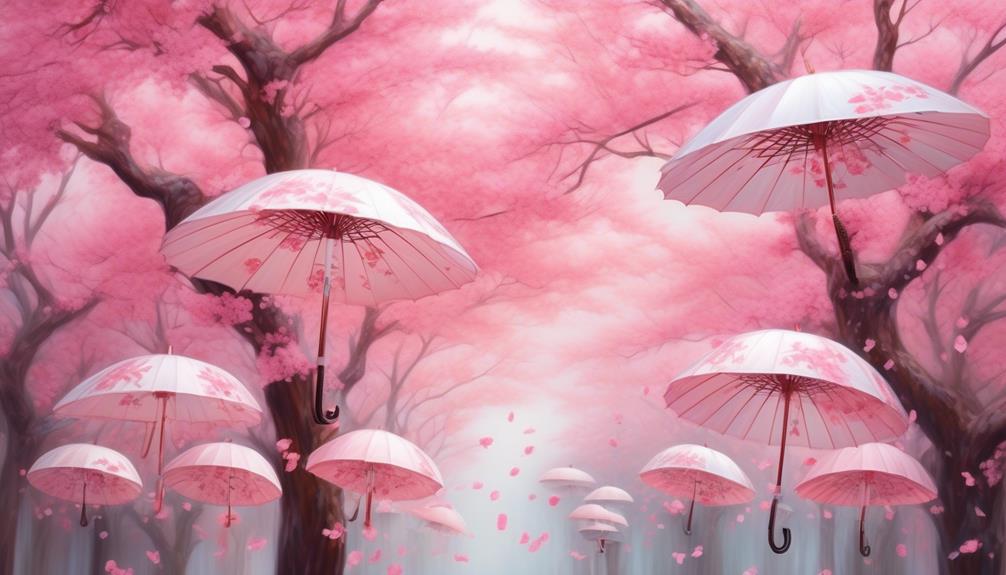
Hand-painted parasols add a vibrant and artistic touch to the Cherry Blossom Festival decorations. These exquisite hand-painted umbrellas are a beautiful display of traditional Japanese artwork, capturing the essence of the festival's cultural significance.
Here are some fascinating aspects of hand-painted parasols:
- Intricate Designs: Each hand-painted parasol showcases intricate designs that reflect the beauty of nature and the delicate cherry blossom flowers. These designs often feature graceful strokes, vibrant colors, and symbolic motifs, such as birds, butterflies, or traditional patterns.
- Skilled Artistry: Creating these hand-painted umbrellas requires exceptional skill and precision. Skilled artisans meticulously paint each parasol by hand, using a combination of traditional techniques and modern materials. The artists' attention to detail ensures that no two parasols are exactly alike, making each one a unique work of art.
- Symbolic Meaning: Hand-painted parasols hold symbolic meaning in Japanese culture. They aren't only decorative but also believed to bring protection and good luck. The parasols' elegant presence during the Cherry Blossom Festival represents a harmonious connection between nature, art, and the celebration of life.
- Festive Atmosphere: When displayed at the Cherry Blossom Festival, hand-painted parasols create a festive atmosphere. Their vibrant colors and intricate designs add to the overall beauty of the event, complementing the blooming cherry blossoms and enhancing the celebratory ambiance.
- Cultural Appreciation: Hand-painted parasols embody the rich cultural heritage of Japan. By incorporating these traditional artworks into the festival decorations, visitors can appreciate and immerse themselves in the essence of Japanese art and craftsmanship.
Wishing Trees
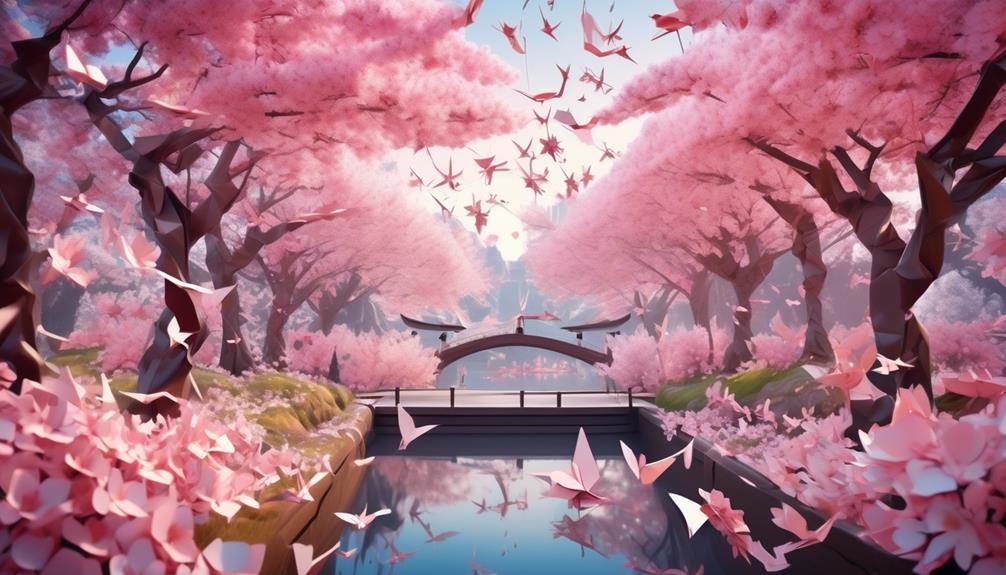
As visitors stroll through the Cherry Blossom Festival, they are captivated by the enchanting presence of the Wishing Trees. These trees hold a deep cultural significance and are an integral part of many traditional wishing tree traditions. People from all walks of life gather around these magnificent trees, adorned with colorful ribbons and paper tags, to make their wishes.
The cultural significance of wishing trees can be traced back to ancient times. In many cultures, trees symbolize strength, longevity, and the connection between heaven and earth. Wishing trees have become a way for people to express their hopes and dreams, seeking blessings and good fortune. It is believed that by tying a ribbon or writing a wish on a tag and hanging it on the branches of the tree, one's desires will be heard by the spirits and the universe.
To better understand the traditions associated with wishing trees, let's take a look at this table:
| Tradition | Cultural Significance |
|---|---|
| Tying ribbons to the tree branches | Symbolizes the connection between the earthly and spiritual realms |
| Writing wishes on paper tags | Expresses hopes, dreams, and desires |
| Hanging the wishes on the tree | Believed to attract positive energy and blessings |
The Wishing Trees at the Cherry Blossom Festival serve as a powerful reminder of the human desire for hope and fulfillment. They create a sense of unity and provide an opportunity for self-reflection. So, next time you visit the festival, don't forget to make a wish and hang it on the branches of these magnificent trees.
Ceramic Pottery
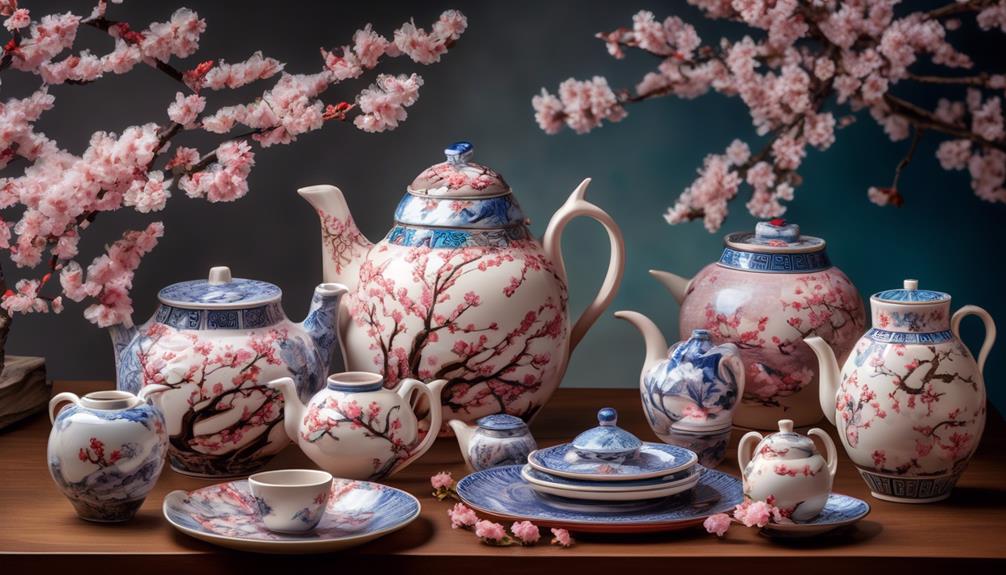
Continuing our exploration of the captivating decorations at the Cherry Blossom Festival, let's now turn our attention to the exquisite world of Ceramic Pottery. The festival showcases a stunning array of ceramic pottery, each piece meticulously crafted and adorned with intricate designs that reflect the beauty of nature and the rich cultural heritage of Japan.
Here are some fascinating aspects of ceramic pottery at the Cherry Blossom Festival:
- Traditional Techniques: Skilled artisans employ traditional methods passed down through generations to create these masterpieces. From shaping the clay to glazing and firing, every step is carefully executed to achieve the desired form and finish.
- Variety of Forms: Ceramic pottery at the festival encompasses a wide range of forms, including vases, bowls, plates, and teapots. Each piece is thoughtfully designed to harmonize with the delicate cherry blossoms and other festival decorations.
In addition to ceramic pottery, the festival also celebrates the artistry of traditional music instruments, which further enhances the immersive experience. Visitors can witness the enchanting sounds of instruments like the shamisen, a three-stringed instrument, or the koto, a thirteen-stringed zither. These instruments, often adorned with intricate carvings and vibrant lacquer finishes, add an ethereal and melodic ambiance to the festival.
The Cherry Blossom Festival's display of ceramic pottery and traditional music instruments showcases the mastery and creativity of Japanese artisans. It's a visual and auditory feast that transports visitors into the enchanting world of Japanese culture and art.
Frequently Asked Questions
What Is the Significance of Lanterns in the Cherry Blossom Festival?
Lanterns hold great significance in the Cherry Blossom Festival. They aren't just decorative, but they also symbolize the cultural heritage of Japan. Lanterns are used to light up the night and create a magical ambiance during the festival.
They represent the beauty and transience of cherry blossoms, as they too bloom for a short period. Lanterns are intricately designed and often adorned with cherry blossom motifs, adding to the overall enchantment of the festival.
How Are Paper Fans Incorporated Into the Festival Decorations?
In the Cherry Blossom Festival decorations, paper fans are incorporated in various ways. These elegant and delicate fans hold great cultural significance in the festival. They're often adorned with beautiful cherry blossom designs, adding a touch of traditional charm to the festivities.
Paper fans are used not only as decorative elements but also as practical tools to keep cool during the festival. The incorporation of paper fans in the decorations truly captures the essence and beauty of the Cherry Blossom Festival.
What Types of Symbolic Ornaments Are Commonly Used in the Cherry Blossom Festival?
Symbolic ornaments play a significant role in the Cherry Blossom Festival. These decorations hold cultural significance and add beauty to the festivities.
Various types of ornaments are commonly used, such as lanterns, origami cranes, and traditional Japanese dolls. These symbols represent different aspects of Japanese culture, including luck, prosperity, and the beauty of nature.
Lanterns illuminate the night, while origami cranes symbolize peace and good fortune.
The festival is a visual feast, with these symbolic ornaments creating a vibrant and meaningful atmosphere for all to enjoy.
How Are Cherry Blossom Trees Used as Decorations During the Festival?
During the Cherry Blossom Festival, cherry blossom trees serve as exquisite decorations, embodying the essence of beauty and renewal. These trees hold deep symbolism, representing the fleeting nature of life and the delicate balance between strength and fragility.
As part of the festival's traditions, the planting of cherry blossom trees is a cherished ritual, symbolizing hope and new beginnings. This tradition not only adorns the festival grounds but also creates a lasting legacy, connecting generations to the rich cultural heritage of the cherry blossom.
What Role Do Hand-Painted Parasols Play in the Festival Decorations?
Hand-painted parasols hold a significant role in the decorations of the Cherry Blossom Festival. These beautifully crafted parasols not only add a vibrant touch to the festivities but also carry cultural significance.
They symbolize protection from the sun and are seen as a representation of elegance and grace. The intricate designs and vibrant colors of the parasols further enhance the festive atmosphere, creating a mesmerizing visual spectacle for all to enjoy.
Conclusion
In conclusion, the cherry blossom festival is a vibrant and enchanting celebration. From lanterns illuminating the night sky to delicate floral arrangements adorning every corner, the festival is a visual feast.
One interesting statistic is that over 1,000 cherry blossom trees are planted and displayed during the festival, creating a breathtaking landscape that attracts millions of visitors each year.
With its symbolic ornaments and stunning decorations, this festival truly captures the beauty and essence of cherry blossoms.
- About the Author
- Latest Posts
Introducing Ron, the home decor aficionado at ByRetreat, whose passion for creating beautiful and inviting spaces is at the heart of his work. With his deep knowledge of home decor and his innate sense of style, Ron brings a wealth of expertise and a keen eye for detail to the ByRetreat team.
Ron’s love for home decor goes beyond aesthetics; he understands that our surroundings play a significant role in our overall well-being and productivity. With this in mind, Ron is dedicated to transforming remote workspaces into havens of comfort, functionality, and beauty.
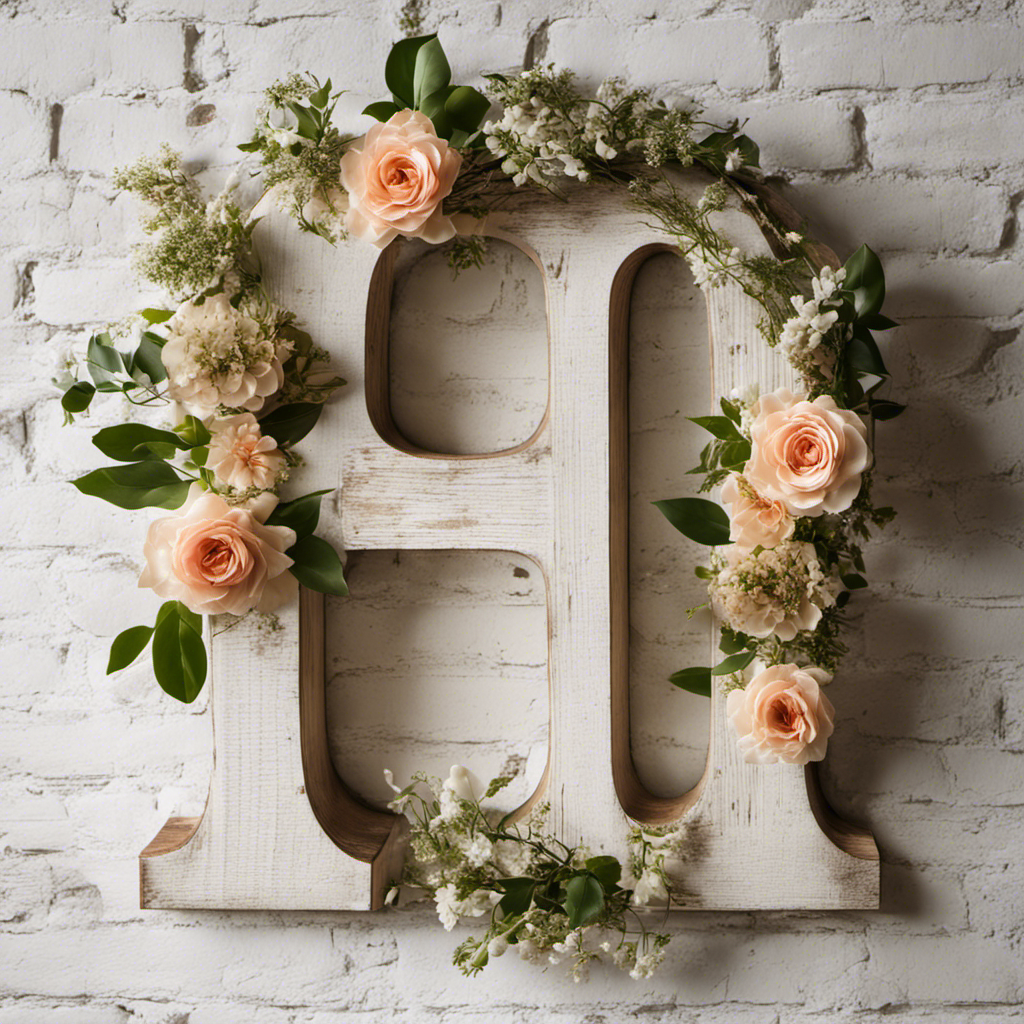
“Home is where the heart is,” is a popular saying. What better way to add warmth and personality to your space than with the classic beauty of wooden letters?
In this article, I’ll share my expertise on how to use wood letters in your decor, from choosing the perfect ones to arranging them creatively. Whether you’re a novice or a seasoned decorator, get ready to elevate your space with the charm and versatility of wood letters.
Key Takeaways
- Incorporate wood letters as statement pieces in a gallery wall or on a shelf for a rustic and personalized touch.
- Use wood letters to label different areas or rooms in your house for a stylish and organized look.
- Prepare wood letters for painting or staining by sanding them to ensure a smooth surface and sealing them for protection and enhanced beauty.
- Arrange wood letters in different patterns or formations to add creativity to your space and personalize them with names, initials, or meaningful quotes for unique gifts.
Choosing the Right Wood Letters for Your Decor
I’m going to find the perfect wood letters to complement my decor.
When it comes to incorporating wood letters in home accessories, there are plenty of design ideas to choose from.
One option is to use large, bold wood letters as a statement piece on a gallery wall. This can add a rustic and personalized touch to any space.
Another idea is to spell out meaningful words or phrases using smaller wood letters and display them on a shelf or mantel. This can be a great way to showcase your values or add a motivational element to your home.
Additionally, you can use wood letters to label different areas or rooms in your house, adding a stylish and organized look.
Whatever design idea you choose, wood letters are a versatile and charming addition to any home decor.
Preparing Wood Letters for Painting or Staining
Before painting or staining, I’ll sand the wood letters to ensure a smooth surface. Sanding is an important step in the preparation process as it helps to remove any rough edges or imperfections. There are different sanding techniques that can be used, depending on the type of wood and the desired finish. For softer woods, like pine, a fine-grit sandpaper is recommended to prevent any damage. Harder woods, such as oak or mahogany, may require a coarser grit to effectively smooth the surface. After sanding, it’s important to seal the wood to protect it from moisture and give it a finished look. There are various sealing options available, including clear varnish, polyurethane, or wood stain. These options not only provide protection but also enhance the natural beauty of the wood.
| Sanding Techniques | Sealing Options |
|---|---|
| Fine-grit sandpaper for soft woods | Clear varnish |
| Coarse-grit sandpaper for hard woods | Polyurethane |
| Sanding block for even sanding | Wood stain |
| Sand in the direction of the wood grain |
Creative Ways to Arrange Wood Letters in Your Space
To add a touch of creativity to your space, try arranging the wood letters in different patterns or formations.
Wood letter crafts for kids are a great way to introduce them to the world of DIY projects while also fostering their creativity.
Personalized wood letter gifts are another popular option, allowing you to customize the letters with names, initials, or meaningful quotes.
You can arrange them on shelves or tables as standalone decor pieces, or incorporate them into larger art installations.
Get creative with the arrangements – stack them, stagger them, or even create a word puzzle by scattering the letters and challenging your guests to put them together.
Adding wood letters to gallery walls and shelves adds a unique and personalized touch to your space.
Adding Wood Letters to Gallery Walls and Shelves
I love how adding wood letters to gallery walls and shelves instantly adds a unique and personalized touch to my space. It’s amazing how a simple arrangement of letters can transform a plain wall into a stunning focal point.
Here are three ways I love to incorporate wood letters in my decor:
-
Arranging wood letters on mantels: By spelling out meaningful words or phrases on my mantel, I create a warm and inviting atmosphere in my living room. It’s a great way to showcase my personality and make a statement.
-
Incorporating wood letters in nursery decor: Wood letters are perfect for creating a personalized space for my little one. I can spell out their name or inspirational words, adding a touch of charm to the nursery.
-
Adding wood letters to gallery walls: When creating a gallery wall, wood letters are a fantastic addition. I can mix and match different sizes and fonts to create an eye-catching display that reflects my style.
By incorporating wood letters in these ways, I can infuse my space with character and make it truly my own.
Now, let’s talk about how to maintain and clean wood letters for longevity.
Maintaining and Cleaning Wood Letters for Longevity
One way I’ve found helpful in maintaining and cleaning my wood letters for longevity is by using a soft cloth and a gentle cleanser.
Proper care is essential in extending the lifespan of wood letters. When cleaning, it’s important to avoid harsh chemicals or abrasive materials that can damage the delicate surface of the wood. Instead, opt for a mild cleanser specifically designed for wood surfaces.
Gently wipe the letters with the soft cloth, being careful not to apply too much pressure. This will prevent scratching or chipping of the wood.
Additionally, it’s crucial to avoid exposing the letters to excessive moisture or extreme temperatures, as these can cause warping or cracking.
Frequently Asked Questions
How Do I Choose the Right Size of Wood Letters for My Decor?
When choosing the right size of wood letters for my decor, I consider the size of the space and the desired visual impact. I also research different paint or stain techniques to effectively customize the letters.
Can I Use Any Type of Paint or Stain on Wood Letters, or Are There Specific Products I Should Use?
I’ve found that using the right type of finishes for wood letters is crucial. There are different products out there, but I recommend using specific paints and stains designed for wood.
Are There Any Unique or Unconventional Ways to Arrange Wood Letters in a Space?
There are countless possibilities for unique arrangements and unconventional placements of wood letters in a space. You can experiment with different sizes, orientations, and even incorporate them into unexpected objects or furniture. Get creative!
How Can I Securely Attach Wood Letters to a Gallery Wall or Shelf?
To securely attach wood letters to a gallery wall or shelf, I recommend using small screws or adhesive strips. For a unique twist, you could also try suspending the letters from clear fishing line for a floating effect.
What Are Some Tips for Preventing Dust Buildup and Keeping Wood Letters Looking Their Best Over Time?
To prevent dust buildup and keep wood letters looking their best over time, I recommend regularly dusting them with a soft cloth or using a gentle brush. Applying a thin coat of furniture polish can also help maintain their appearance.
Can Wood Letters be Incorporated into Rustic Decor?
Yes, wood letters can definitely be incorporated into rustic decor ideas. They add a charming and natural touch to any space, whether it’s a cozy cabin or a country farmhouse. You can use them to spell out words or simply as decorative accents on shelves or mantels.
Conclusion
In conclusion, wood letters are a versatile and stylish addition to any decor. Not only can they be customized to fit your personal style, but they also add a unique touch to your space.
Did you know that incorporating wood elements into your interior design can reduce stress levels by up to 30%?
So, why not give wood letters a try and enjoy the benefits of a calming and beautiful environment.
- About the Author
- Latest Posts
Meet Katherine, the creative enthusiast at ByRetreat who infuses her boundless passion for design into every remote workspace she crafts. With an innate sense of creativity and an eye for unconventional beauty, Katherine brings a unique and inspiring perspective to the team.
Katherine’s love for design is infectious, and her ability to think outside the box sets her apart. She believes that true artistry lies in embracing a variety of styles and mixing them harmoniously to create captivating spaces. By combining different textures, colors, and patterns, Katherine weaves a tapestry of creativity that breathes life into each remote workspace.
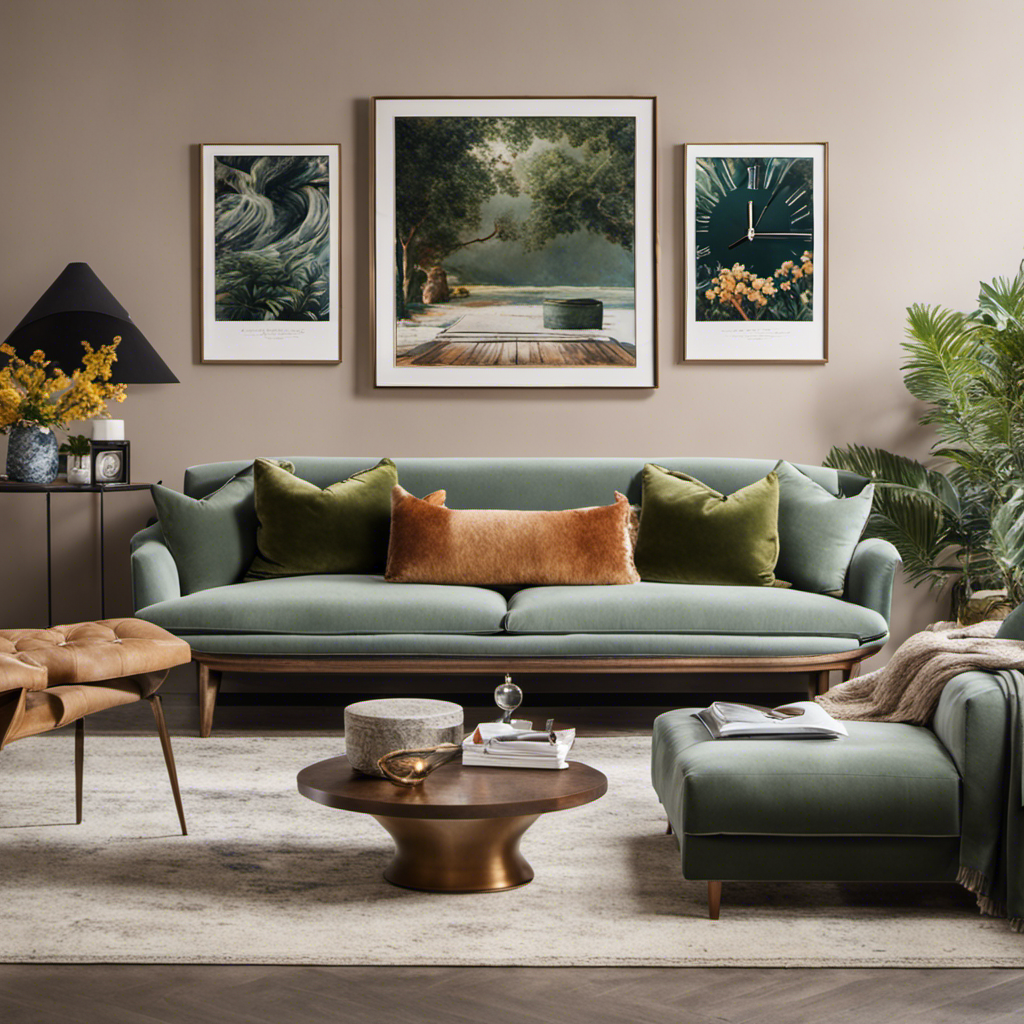
Have you ever thought about what kind of decoration to hang above your TV to really make it stand out in your living room? Look no further! In this article, we will discuss various options, sizes, and unique ideas to assist you in finding the ideal piece.
Whether you’re into framed art, wall-mounted shelves, or even mirrors, we’ve got you covered.
So, sit back, relax, and get ready to transform your TV area into a stylish and eye-catching space.
Key Takeaways
- Consider the size of the wall space above your TV when choosing decor
- Hang framed art or photographs to add a personal touch
- Use wall-mounted shelves or cabinets to create a functional and stylish display
- Incorporate mirrors to add visual interest and create the illusion of a larger room
Choosing the Right Size
You should consider the size of the wall space above your TV when choosing the right decor. Proper placement is key to creating a visually appealing and balanced look in your living room.
The size of the wall space will determine the scale of the decor you choose. If the space is small, opt for smaller pieces such as framed artwork or a collection of smaller prints. This will prevent the decor from overwhelming the TV and creating a cluttered look.
On the other hand, if you’ve a large wall space, you can go for a larger statement piece or create a gallery wall with multiple pieces. When selecting the decor, also consider choosing complementary colors that will enhance the overall aesthetic of the room.
For example, if your TV is black, consider adding pops of color through your decor to create visual interest. By considering the size of the wall space and choosing complementary colors, you can create a cohesive and visually pleasing look above your TV.
Framed Art and Photographs
Hang some framed art or photographs to add a personal touch to your TV wall. By incorporating canvas prints or vintage posters, you can create a unique and stylish focal point that complements your television. These pieces of artwork not only enhance the aesthetics of your space but also reflect your personality and interests.
To help you choose the perfect artwork, consider the size and style that will best suit your TV wall. For instance, if you’ve a large television, opt for a statement piece or a gallery wall of smaller frames. On the other hand, for a smaller TV, a single oversized canvas print can make a bold statement.
Now, let’s explore how wall-mounted shelves and cabinets can further enhance the functionality and style of your TV wall.
Wall-mounted Shelves and Cabinets
Place a few wall-mounted shelves or cabinets around your TV to create additional storage space for your electronics and decor items. Floating shelves are a great option for this, as they provide a sleek and modern look. You can arrange them in a symmetrical or asymmetrical pattern, depending on your personal style. Consider creating a gallery wall above your TV by mixing and matching different-sized shelves and incorporating photographs, artwork, and decorative items. This won’t only add visual interest but also allow you to showcase your favorite pieces. Use the shelves to display books, plants, or even small sculptures.
The possibilities are endless! With the addition of wall-mounted shelves and cabinets, you can optimize the space around your TV and transform it into a stylish and functional area.
Now, let’s move on to another great option for enhancing your TV wall: mirrors and decorative mirrors.
Mirrors and Decorative Mirrors
One way to add visual interest to your TV wall is by incorporating mirrors and decorative mirrors. Mirrors not only enhance the aesthetics of your space but also create the illusion of a larger room. Here are three ideas to inspire you:
-
Wall sconces and lighting fixtures: Install wall sconces on either side of the mirror to create a balanced and stylish look. The soft glow of the lights won’t only illuminate your TV wall but also add a cozy ambiance to the room.
-
DIY wall decor ideas: Get creative and make your own unique mirror designs. You can use different shapes, sizes, and frames to match your personal style. Consider adding embellishments like beads or paint to make your mirrors truly one-of-a-kind.
-
Grouped mirrors: Create a captivating focal point by grouping various mirrors together. Mix and match different sizes and shapes for an eclectic and eye-catching display. Play around with the arrangement until you find a configuration that suits your taste.
With these mirror ideas, your TV wall will become an artful and captivating centerpiece in your living space.
Creative Display Ideas
Get inventive with your display by arranging various decorative objects in a unique and eye-catching way. When it comes to displaying decor above your TV, there are plenty of display techniques and alternative options to explore.
One creative idea is to create a gallery wall above your TV. Mix and match different sized frames and artwork to add visual interest.
Another option is to use floating shelves and arrange a collection of decorative items, such as vases, candles, and small plants. This not only adds depth to your display but also gives you the flexibility to switch out items whenever you want.
If you want to go for a minimalist look, consider installing a sleek floating ledge and placing a few statement pieces on it.
The key is to experiment with different arrangements until you find the perfect display that reflects your style and personality.
Frequently Asked Questions
Can I Use a Large Mirror as a Decorative Piece Above My Tv?
Yes, you can definitely use a large mirror as a decorative piece above your TV. It adds a touch of elegance and reflects light, making the room feel brighter. Consider incorporating plants and string lights to enhance the display even more.
What Are Some Creative Ways to Display Family Photos Above the Tv?
Get creative with your family photos above the TV! Try a DIY photo gallery with eclectic frames, mix sizes and shapes for visual interest. Showcase your loved ones in a unique and personal way.
How Do I Choose the Right Size of Artwork to Hang Above My Tv?
To choose the right size of artwork above your TV, consider the dimensions of the TV and the wall space. Measure the width of the TV and leave some space on each side. Hang the artwork at eye level for optimal viewing.
Are There Any Specific Guidelines for Arranging Wall-Mounted Shelves and Cabinets Around the Tv?
Arranging a gallery wall around the TV? Remember, balance is key. Start with larger pieces in the center and build outwards. As for floating shelves, mix decorative items with practical storage to create a stylish and functional display.
Can I Use a TV Stand Instead of Wall-Mounting the TV, and What Decor Options Are Available for That Setup?
You can opt for a TV stand instead of mounting the TV. When it comes to decor, minimalist options work well. Consider sleek shelves, art pieces, or plants to create a stylish and clutter-free look.
– What Type of Decor Would Be Suitable to Hang Above Corbels?
When choosing decor to hang above corbels, consider the projection distance for corbels to ensure proper balance and support. Artwork, mirrors, or decorative shelves can complement the corbels while adding a touch of elegance to the space. Select pieces that harmonize with the surrounding decor and highlight the architectural details.
Conclusion
In conclusion, when it comes to choosing the perfect decor above your TV, the possibilities are endless.
Whether you opt for a beautifully framed artwork, a sleek wall-mounted shelf, or a captivating decorative mirror, the key is to select something that complements your style and enhances the overall aesthetics of the room.
Let your imagination soar and create a visual masterpiece that will captivate and inspire all those who enter your space.
- About the Author
- Latest Posts
Meet Bethia, the visionary designer at ByRetreat who brings a touch of magic to every remote workspace she creates. With a boundless imagination and an eye for beauty, Bethia is passionate about transforming ordinary spaces into extraordinary havens of creativity and comfort.
Bethia possesses a unique talent for envisioning the perfect combination of furniture, colors, and textures that harmonize seamlessly in a room. She understands that selecting furniture goes beyond mere functionality; it’s about curating pieces that evoke a sense of style and sophistication while enhancing the overall ambiance.

As someone who is passionate about interior design, I have always believed that the proper font can either enhance or detract from the visual appeal of a room.
So, imagine my excitement when I discovered the popular font used for home decor that’s taking the design world by storm.
From sleek and modern to whimsical and playful, this font has the power to transform any room into a visual masterpiece.
Curious to know more? Join me as we delve into the fascinating world of typography and its impact on home decoration.
Key Takeaways
- Serif fonts add sophistication and tradition to home decor.
- Sans-serif fonts create a contemporary and minimalistic feel in living spaces.
- Script fonts add a sense of elegance and playfulness to the overall aesthetic.
- Font choice in home decor reflects the personality and style of the homeowner.
The Impact of Typography on Home Decor
I love how typography can completely transform the aesthetic of home decor. The psychology of fonts in home decor is fascinating to me. Different font styles have the power to evoke different emotions and create various atmospheres in a space.
It’s incredible how something as simple as the shape of letters can influence the overall ambiance of a home. Serif fonts, with their elegant and classic look, can add a touch of sophistication to any room.
On the other hand, sans-serif fonts, with their clean and modern lines, can give a space a contemporary and minimalistic feel. The choice of font can make a statement and reflect the personality of the homeowner.
It’s amazing how such a small detail can have such a big impact on the overall design.
Exploring the Role of Fonts in Interior Design
When designing the interior of a space, it’s crucial to consider the impact of different fonts on the overall aesthetic. The psychology of font choice in interior design plays a significant role in creating the desired ambiance and atmosphere in a home.
Here are three ways fonts can influence the typography on home ambiance:
-
Font Personality: Just like people, fonts have personalities. Choosing a font with a playful and whimsical personality can create a fun and lighthearted atmosphere, while a more elegant and sophisticated font can evoke a sense of luxury and refinement.
-
Font Legibility: The legibility of a font is essential for creating a comfortable and inviting space. Opting for clear and easy-to-read fonts ensures that information and messages are easily understood, enhancing the overall user experience.
-
Font Style: Different font styles can evoke specific emotions. For example, a bold and impactful font can make a statement and create a sense of power, while a delicate and flowing font can evoke feelings of tranquility and serenity.
Considering these factors when choosing fonts for interior design can greatly enhance the overall ambiance and aesthetic of a space.
Font Trends in Home Decoration
One trend I’ve noticed in interior design is the increasing use of unique and unconventional fonts to add a touch of creativity and personality to spaces. Font choices play a significant role in home decor branding, as they can evoke different emotions and set the overall tone of a room. The psychology of fonts in interior design is fascinating, as certain fonts can create a sense of elegance, playfulness, or sophistication. To give you an idea of the variety of fonts used in home decoration, here is a 2 column and 5 row table showcasing different font styles:
| Font Style | Description |
|---|---|
| Serif | Classic and traditional, perfect for creating a sense of elegance. |
| Sans-serif | Clean and modern, ideal for minimalist and contemporary designs. |
| Script | Elegant and decorative, often used in formal and romantic settings. |
| Handwritten | Personal and whimsical, adds a touch of uniqueness to any space. |
| Display | Bold and eye-catching, great for making a statement in a room. |
With the right font choice, you can transform a space and make it truly memorable. So, next time you’re designing your home, don’t forget to consider the power of fonts in creating a visually appealing and personalized environment.
Choosing the Right Typeface for Your Home
After researching different typefaces, I’ve discovered that selecting the right typeface for my home is crucial in setting the desired atmosphere and conveying a specific style. Typography considerations for different home styles play a significant role in creating a cohesive and visually appealing space.
Here are three sub-lists to engage you:
-
Traditional Home Style:
- Consider classic serif fonts like Times New Roman or Baskerville.
- Opt for elegant and ornate letterforms to enhance the traditional aesthetic.
- Incorporate script fonts for a touch of sophistication.
-
Modern Home Style:
- Choose sleek and minimalist sans-serif fonts like Helvetica or Futura.
- Embrace clean lines and simplicity in typography to complement the contemporary design.
- Experiment with bold and geometric typefaces for a modern twist.
-
Rustic Home Style:
- Explore hand-lettered and vintage-inspired fonts for a rustic vibe.
- Use distressed or weathered typefaces to evoke a sense of nostalgia.
- Incorporate font choices into furniture and accessories, such as engraved wooden signs or printed textiles.
How Fonts Can Transform the Look of Your Living Space
I love how different typefaces can completely transform the look and feel of my living space. Font selection, for me, isn’t just about finding a style that matches my personality, but also a form of self-expression in interior design.
Each font has its own unique personality, and by carefully choosing the right one, I can convey a specific mood or message in my home. The psychology behind font choices in home decor is fascinating.
Serif fonts, like Times New Roman, can create a sense of tradition and elegance, while sans-serif fonts, like Helvetica, give a clean and modern look. Script fonts, on the other hand, add a touch of whimsy and playfulness.
Frequently Asked Questions
How Do Different Fonts Affect the Overall Mood and Atmosphere of a Room?
Different fonts in home decor can have a significant impact on the overall mood and atmosphere of a room. Fonts that exude warmth and coziness create a welcoming ambiance, while sleek and minimalist fonts give a modern and sophisticated vibe. The psychology of fonts in home decor is fascinating as they can evoke various emotions and shape our perceptions of a space.
Are There Any Specific Fonts That Are More Commonly Used in Traditional Home Decor Styles?
In modern home decor styles, popular fonts can greatly impact the overall aesthetic of a room. From sleek and minimalist to ornate and traditional, font choice plays a crucial role in setting the desired tone and atmosphere.
Can Different Fonts Help to Create a Sense of Coherence and Continuity Throughout a Home?
Using different fonts can create a sense of coherence and continuity throughout a home. Font selection impacts the perceived size and spaciousness of a room. Bold and decorative fonts can be used to create statement pieces in home decor.
Are There Any Fonts That Are Considered to Be Timeless and Never Go Out of Style in Home Decor?
When it comes to fonts in modern home decor, the impact of font choice on the overall aesthetic of a room cannot be underestimated. Certain fonts have a timeless quality that never goes out of style.
Can Fonts Be Used to Highlight or Emphasize Certain Elements or Focal Points in a Room?
Fonts can be used to create a focal point in home decor by choosing a bold and eye-catching font for signage or typography on a statement wall. Creative ways to incorporate fonts include using vinyl decals, stencils, or custom-made signs.
Is the Popular Font Used for Home Decor Reflective of My Home Decor Style?
When it comes to home decor, the font you choose can say a lot about your style. If you’re wondering how to discover your home decor style, take a look at the fonts you’re drawn to. A sleek, modern font might point to a minimalist style, while a more decorative font could indicate a love for eclectic decor.
Conclusion
In conclusion, fonts have a fascinating and formidable impact on home decor. The right typeface can truly transform the look and feel of your living space, adding depth and complexity to your design.
From sleek and modern fonts to elegant and timeless ones, there’s a plethora of options to choose from. So, don’t underestimate the power of typography when it comes to creating a visually appealing and innovative home ambiance.
- About the Author
- Latest Posts
Meet Katherine, the creative enthusiast at ByRetreat who infuses her boundless passion for design into every remote workspace she crafts. With an innate sense of creativity and an eye for unconventional beauty, Katherine brings a unique and inspiring perspective to the team.
Katherine’s love for design is infectious, and her ability to think outside the box sets her apart. She believes that true artistry lies in embracing a variety of styles and mixing them harmoniously to create captivating spaces. By combining different textures, colors, and patterns, Katherine weaves a tapestry of creativity that breathes life into each remote workspace.
-
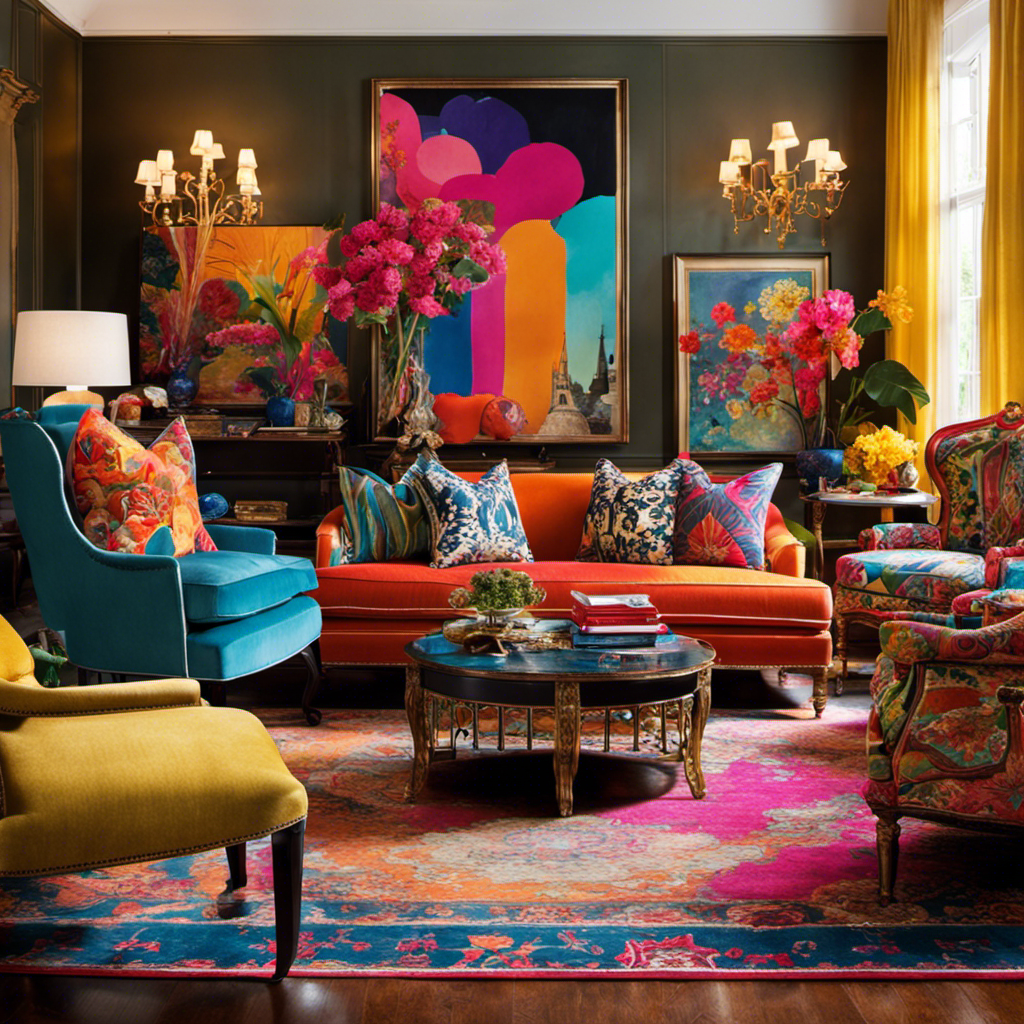
 Decor2 weeks ago
Decor2 weeks agoMaximalist Decor Explained: Embrace More Style
-

 Vetted3 weeks ago
Vetted3 weeks ago15 Best Foot Massagers for Neuropathy to Soothe Your Feet and Relieve Discomfort
-

 Vetted3 weeks ago
Vetted3 weeks ago15 Best Sports Laundry Detergents for Keeping Your Activewear Fresh and Clean
-
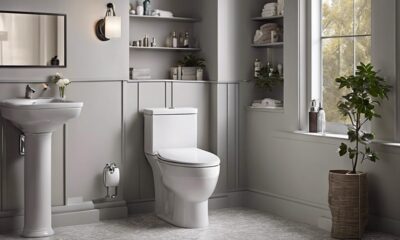
 Vetted4 weeks ago
Vetted4 weeks ago15 Best Tall Toilets for Seniors That Combine Comfort and Safety
-
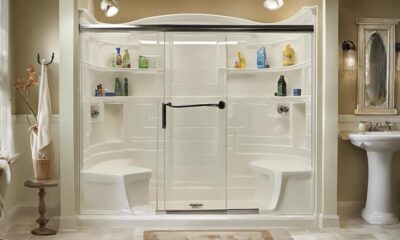
 Vetted5 days ago
Vetted5 days ago15 Best Cleaners for Fiberglass Showers to Keep Your Bathroom Sparkling Clean
-
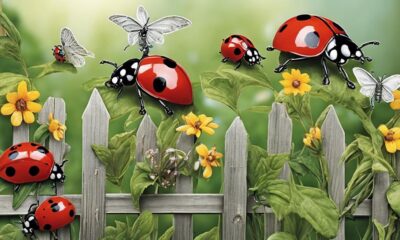
 Vetted1 week ago
Vetted1 week ago15 Best Organic Pest Control Solutions for a Naturally Pest-Free Home
-
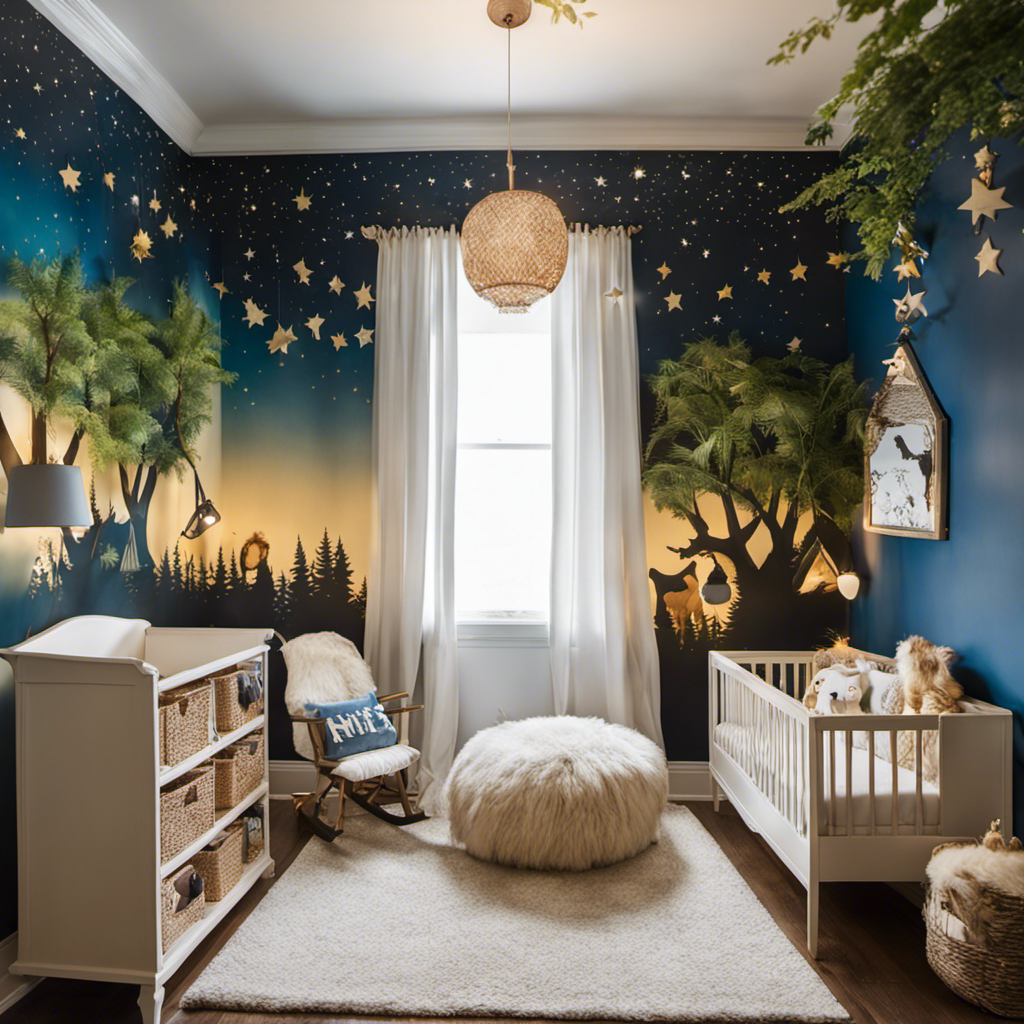
 Decor3 weeks ago
Decor3 weeks agoWhere the Wild Things Are Nursery Decor
-

 Architecture Home Styles3 weeks ago
Architecture Home Styles3 weeks agoExploring the Difference Between Traditional and Contemporary Styles




